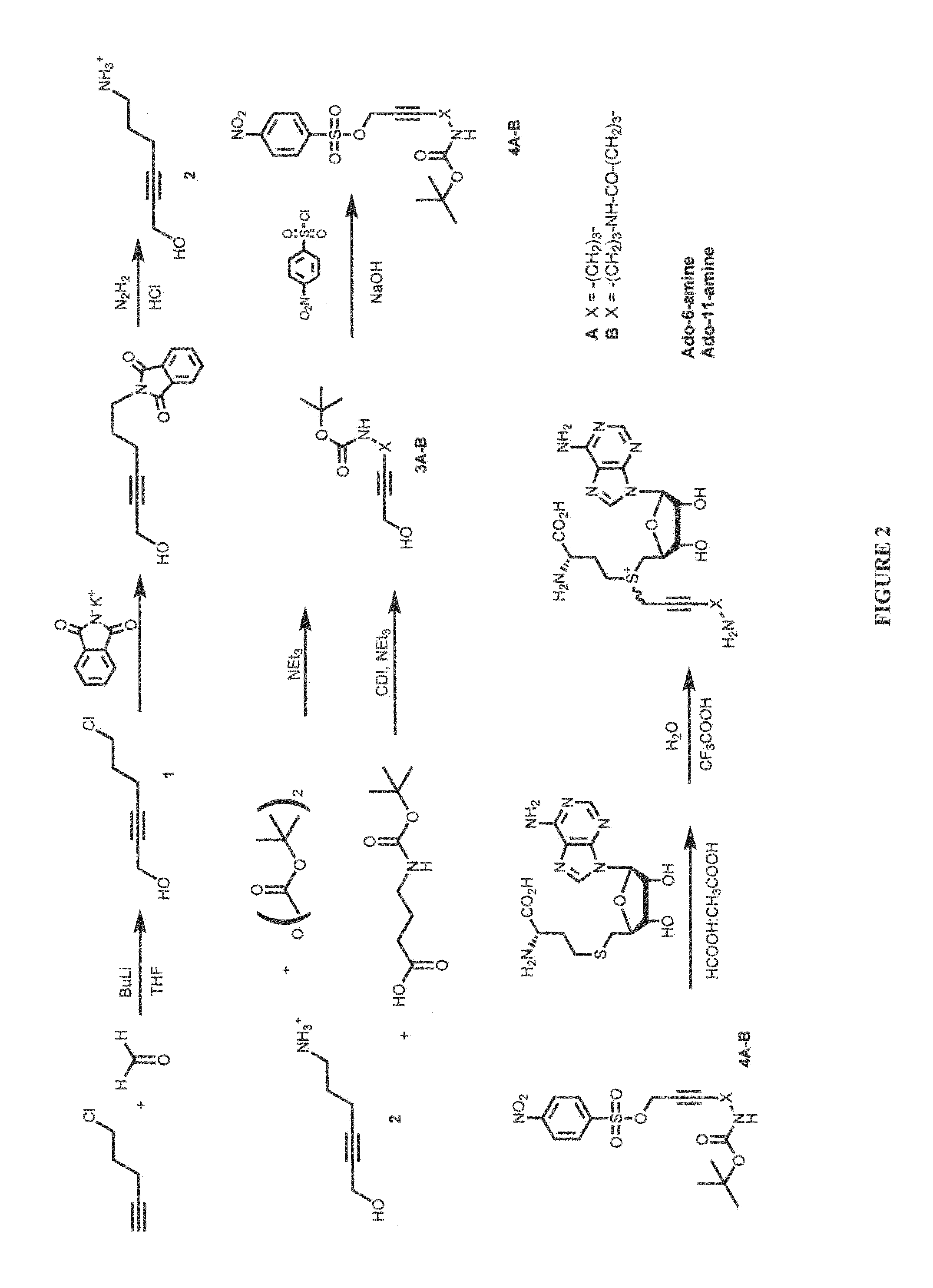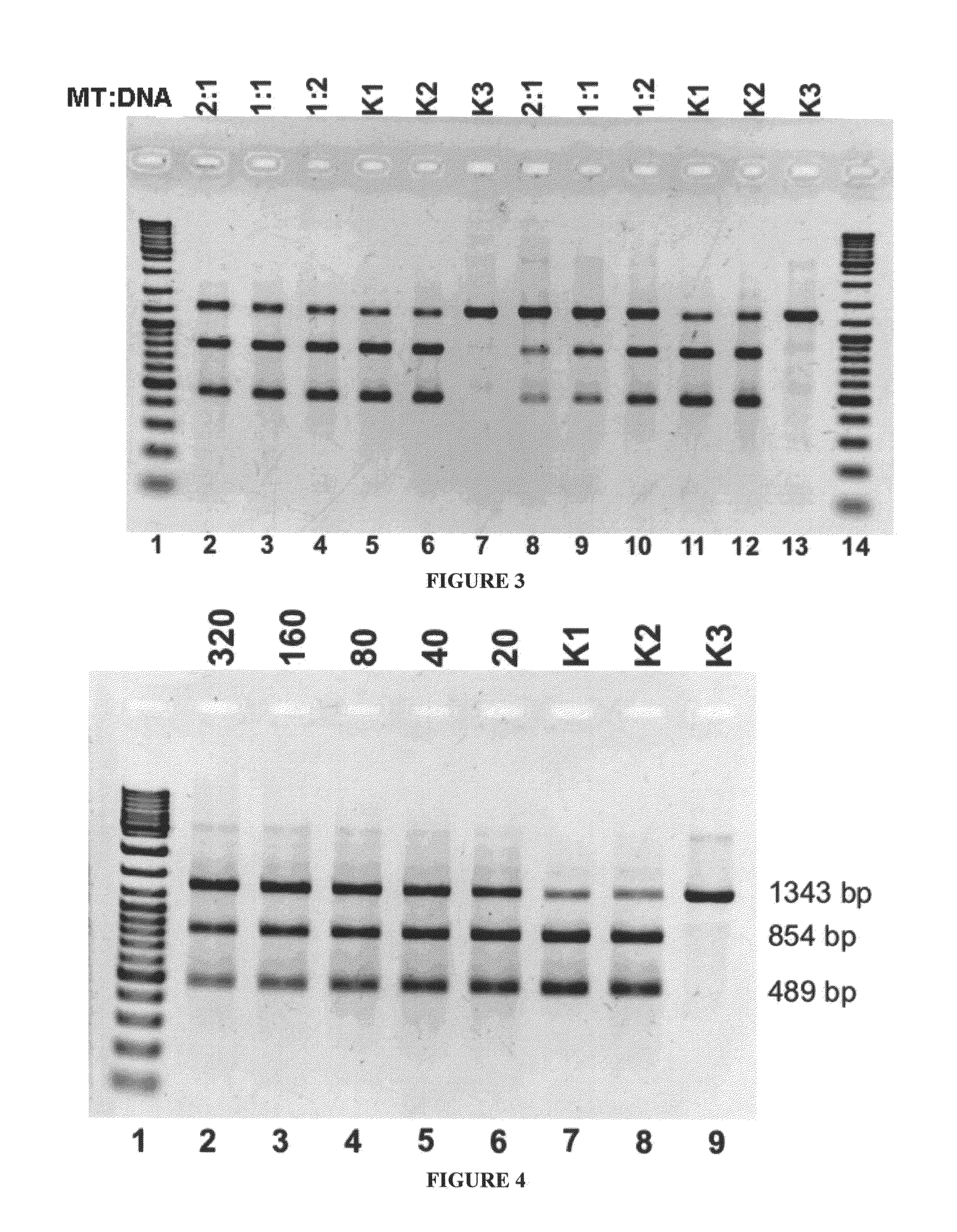Analysis of methylation sites
a methylation site and analysis technology, applied in the field of analysis of methylation sites, can solve the problems of hampered epigenetic misregulation and its diagnostics research, no universal method exists, and the most laborious and cost-intensive epigenetic sequencing technique, and achieve efficient labeling of modified dna molecules, low level of off-target methylation, and low cost
- Summary
- Abstract
- Description
- Claims
- Application Information
AI Technical Summary
Benefits of technology
Problems solved by technology
Method used
Image
Examples
example 1
Design and Chemical Synthesis of AdoMet Analogs
[0138]Studies of the stability of the previously described cofactor (Ado-9-amine, Lukinavicius et al. 2007) containing the butyn-2-yl moiety showed its short halflife (7 minutes) in reaction buffers due to addition of a water molecule to the triple bond. We thus replaced the butynyl shuttle moiety with a hexyn-2-yl moiety such that the separation between the triple bond and the polar amido group is increased from 1 to 3 carbon units. Two synthesized cofactors, Ado-6-amine and Ado-11-amine co-factors, with the overall side chain length of 6 and 11 units, respectively, showed much higher halflifes (about 2 h) in reaction buffers.
[0139]FIG. 2 shows the structure and general synthetic route to Ado-6-amine and Ado-11-amine cofactors. In particular, synthesis of the new cofactors included a N—BOC-protected 6-amino-2-hexyne-1-ol intermediate, which was obtained from 5-chloro-pentyne-1 in three synthetic steps as shown in FIG. 2.
[0140]Chemical ...
example 2a
Selected Mutants of M.HhaI, M.HpaII and M.SssI Methyltransferases are Capable of Coupling Sidechains from the Cofactors Ado-6-Amine and Ado-11-Amine to DNA
[0157]Our approach is based on exploiting the following three DNA methylation enzymes: M.HhaI (GCGC), M.HpaII (CCGG) and M.SssI (CG). It was also shown that engineering of the cofactor pocket of M.HhaI by conversion of certain conserved residues (Q82 and N304 in conserved motifs IV and X, respectively) to alanine leads to a significant improvement of the transalkylation activity with synthetic AdoMet analogs (Dalhoff et al., Nat Protoc. 2006; 1, 1879-86, Lukinavicius et al. J. Am. Chem. Soc. 2007, 129, 2758-2759; Nelly et al., Chem. Sci. 2010, 1, 453-460).
[0158]The Y254S mutation was introduced into the original enzyme as well as into the subsequent engineered versions. We found that indeed the Y254S mutation is beneficial for the transalkylation activity and permits for lower concentrations of the cofactor analogs in the labeling...
example 2b
Mutant of M.HhaI Methyltransferases is Capable of Coupling a Sidechain from a Cofactor Comprising Biotin to DNA
[0165]FIG. 6 shows the synthesis of Ado-biotin cofactor.
[0166]6-Chlorohex-2-yn-1-ol was treated with triphenylmethylmercaptane (tritylmercaptane, TrSH) and then with 4-nitrophenylsulfonyl chloride (NsCl) to give S-protected-O-activated 6-mercaptohex-2-yn-1-ol. The latter is used to alkylate S-adenosylhomocyesteine (AdoHcy) as described (Lukinavicius 2007). After removal of the trityl protecting group by treatment with triethylsilane and coupling with BiotinMaleimide (N-biotinoyl-N′-(6-maleimidohexanoyl)hydrazide, Sigma B1267), racemic Ado-biotin cofactor was obtained. HRMS analysis: calculated for C40H58N11O10S3+ M / Z=948.3525; found: 948.3520
[0167]FIG. 7 shows the enzymatic activity of M.HhaI with cofactor Ado-biotin.
[0168]Bacteriophage lambda DNA was treated with Ado-biotin cofactor (290 □M) in the presence of M.HhaI (variant Q82A / Y254S / N304A) for 2 h at 37 C, and then mod...
PUM
| Property | Measurement | Unit |
|---|---|---|
| Fraction | aaaaa | aaaaa |
| Distance | aaaaa | aaaaa |
| Affinity | aaaaa | aaaaa |
Abstract
Description
Claims
Application Information
 Login to View More
Login to View More - R&D
- Intellectual Property
- Life Sciences
- Materials
- Tech Scout
- Unparalleled Data Quality
- Higher Quality Content
- 60% Fewer Hallucinations
Browse by: Latest US Patents, China's latest patents, Technical Efficacy Thesaurus, Application Domain, Technology Topic, Popular Technical Reports.
© 2025 PatSnap. All rights reserved.Legal|Privacy policy|Modern Slavery Act Transparency Statement|Sitemap|About US| Contact US: help@patsnap.com



